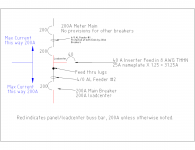Greetings group I have got a small residential PV system inverter to connect.
The house has a lot of panels, there is a 200A meter/main that feeds a empty main breaker outdoor 200A panel with feed thru lugs that feed a indoor panel main lug like so:
Utility---->Meter/200A main --->feeders--->200A 4 spot w/ feed thru Panel 3R ---> Indoor main lug panel.
I would like to land the PV breaker in the 200A 4 spot.
So it looks like my options are 705.12(B)(1)(a) OR 705.12(B)(1)(b)
I am wondering if I can just reverse the 200A 4 spot, land the feeder from the utility on the 'feed thru lugs' use the 200A breaker to feed the house panel? Seems like that would comply with 705.12(B)(1)(a) though it
might be a UL violation, I am going to look at the panel tomorrow and see what the sticker says.
I believe the conductors are 4/0 AL
Thoughts opinions?
Thanks in advance
The house has a lot of panels, there is a 200A meter/main that feeds a empty main breaker outdoor 200A panel with feed thru lugs that feed a indoor panel main lug like so:
Utility---->Meter/200A main --->feeders--->200A 4 spot w/ feed thru Panel 3R ---> Indoor main lug panel.
I would like to land the PV breaker in the 200A 4 spot.
So it looks like my options are 705.12(B)(1)(a) OR 705.12(B)(1)(b)
I am wondering if I can just reverse the 200A 4 spot, land the feeder from the utility on the 'feed thru lugs' use the 200A breaker to feed the house panel? Seems like that would comply with 705.12(B)(1)(a) though it
might be a UL violation, I am going to look at the panel tomorrow and see what the sticker says.
I believe the conductors are 4/0 AL
Thoughts opinions?
Thanks in advance


